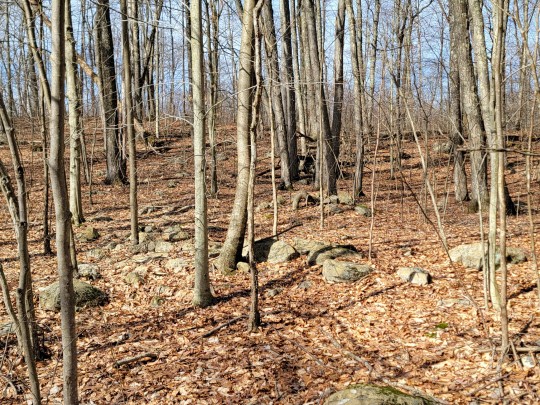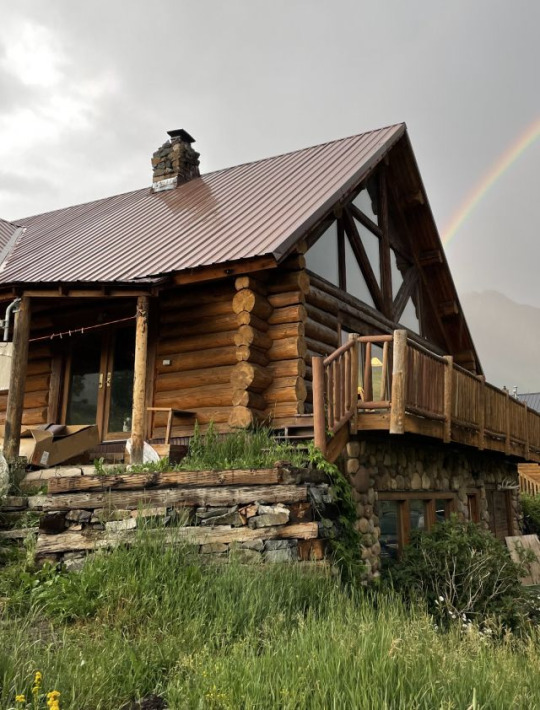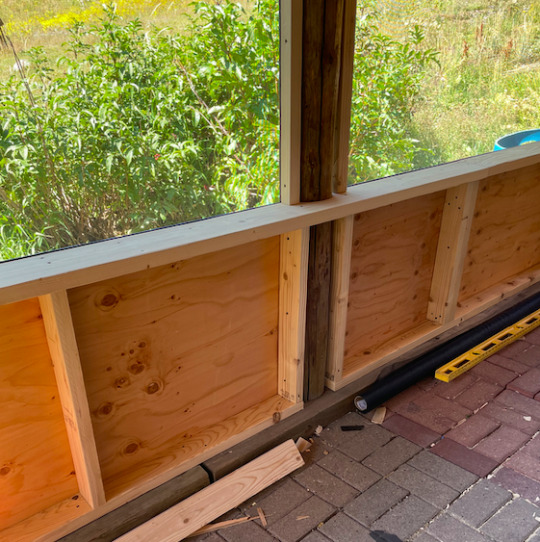#the tribe maintained these when the forest was new from the field and prior to that as well
Text

Forgotten ceremonial stone landscape, New Jersey
#this is more to document a loss#notice the broken trail tree in the upper center... you can see the bend break#the tribe maintained these when the forest was new from the field and prior to that as well#this is probably a newer knock down#it was a turtle Monument#they look like rocks in the woods to those who dont know the forms
7 notes
·
View notes
Text
I'm not sure if that's a good thing
“Well you’re definitely the first.”
This past week, we screened-in the eastern facing porch on the side of the cabin. The porch slopes to the South, with the brick-on-dirt floor crumbling in that direction as well until it reaches uneven slabs of stone acting as steps down to the “yard” below. A mixed material retaining wall wraps beneath the steps to the south facing garage, holding up one corner of the narrow deck on the front of the house. The deck, in the heat of a high altitude summer, droops off the house like it’s daydreaming about the winter snow’s embrace. It’s safe to sit on, though I would not recommend leaning on the railing.

The side porch takes the brunt of the wind. Our wooden rocking chairs have been rocked some 20 feet into the yard more than once in the two months we lived here. In the myriad of threats we heard about the weather, most people included the wind. We all know how I feel about this ongoing weather intimidation tactic. I asked, “what speed are the gusts?”
“Oh, they get up to 70 miles per hour on some days.”
This was the first quantifiable piece of weather information someone had offered — an actual number we could react to with data and our historical personal experiences of various weather events. And our reaction was: uhhhh…. OK????
Look, I get it. No one’s preaching the skin benefits of -20 degree wind gusts at 70 mph, building snow drifts against your house in the span of minutes that Cooper could die in. I am not going to pretend that’s pleasant. But 70 mph? Any wind I’ve driven faster than does not intimidate me. I used to rally the horses at 12 years old in winds over 70mph to get them in the barn before the latest tornado whipped through. I helped shutter the resort in the BVI as the Category 5 hurricane rolled in. Even in Topanga, 70 mile per hour gusts were not uncommon in Santa Ana events. We had our single pane windows shatter more than once from debris in the wind. We taped cardboard up and went to sleep.
That “70 mph” was all I needed to hear to confirm our next project: we were going to build a catio for these cats, and we were going to do it on the pre-existing porch structure to save time and money.
We spent a week framing out the structure. We had to carve into the logs of the house to embed the wood supports for the framing.

And from there, every piece of wood was custom carved and cut to fit around the existing timber supports. The existing porch was so wildly uneven that there are gaps between each piece of old wood and the new framing. Our plan is to mix all the wood chips from the project with mortar/chinking and stuff the gaps — a good solution for the log cabin look. We built a plywood pony wall up to 28 inches from the interior of the porch, which gives a height of ~4-5ft from the exterior ground below. It’s capped with a 2x6” railing for even the fluffiest of cats to find a perch. The exterior will be wrapped with corrugated metal that we’ll quick-age to match the metal that wraps the bottom of the cabin. On the interior of the porch, we’ll use shiplap to hide the framing.



The screens themselves can withstand winds up to 120 mph, but to-be-determined if they can hold the weight of a growing maniac cat who has already tried to climb them. In the event the screens succumb to cat (or wind or snow or neighbor judgment) we’ll reinforce with metal mesh. We’re going to maintain this screen porch regardless of what the screen is.
We had the pleasure of running into one of our more industrious neighbors the other day, and Ben asked him, “hey we’re building a screen porch. Is this a terrible idea?”
He laughed. “Well you’re definitely the first.” But he liked it. Great way to diminish wind into the house. Simple way to regulate the temperature with massive south-facing windows. And indeed a practical outdoor safe haven for cats in predator territory. Just because you’re the first doesn’t mean you’re foolish — just foolhardy. There’s plenty of that here.
This town has the typical mountain town’s truncated version of a colonizers’ history: “established 1881.” But it was plenty established prior to that by the Uncompahgre Band of the Ute Nation, removed by the U.S. Army on September 7, 1881, nearly 140 years ago. The government relocated the Uncompahgre Ute People to Utah, and one year after the Ute were forcibly removed from their ancestral land, San Miguel County split off from Ouray County and was made its own political subdivision in the newly-formed State of Colorado.
In 1879, the ore-laden valley already had 50 people living in it, with a new narrow gauge railway only 2 miles away. By 1885, it was a town of 200 people. There was a hotel, a couple saloons, a pool hall. Winters were treacherous; the valley was and is prone to avalanches. But where there’s gold, there’s gumption. The power needed to run the stamp mill to process ore drove innovation. Timber was scarce at such high elevations, so a wood powered steam mill wouldn’t cut it. But the San Miguel River just a few miles down from the mine looked promising. Thus began the development and construction of the Ames Hydroelectric Generating Plant. It was a hit. In fact, it was so successful that the Ames Plant led to the adoption of alternating currents at Niagara Falls and eventually to being adopted worldwide as a viable power solution.
The plant remains, but the gold rush obviously didn’t. By 1940, the U.S. Census declared this little town I call home as tied for the lowest population in the country: 2 people. By 1960, it was one of four incorporated towns in the U.S. with no residents. But the joke was on the Census — the town’s single resident was just out of town the day the census came through. 1960 population: 1.
By 1980 the population grew to 38, 69 in 1990, and about 180 now. (Plus 51 dogs according to the town’s website.) With modern amenities, it’s easier to be here. Studded snow tires, satellite internet, solar panels, instant coffee. No matter the hardships, there’s the reality of the present. In the 1880s, as the town boomed, the Ouray Times declared, “it will be at no distant day a far more pretentious town than it is now.” That day hasn’t exactly arrived, but I guess it depends on what you consider pretentious. I don’t think the town claims any airs of excellence beyond what’s true. In fact, the town hardly claims anything at all. There’s no sign indicating it’s even here. There’s just the old side and the new side.
The new side, the Eastern half, was drawn out in the early 1990s, some 100 years later, and is separated from the Old Town by an avalanche zone—preserved open space for hiking in the summer, preserved open space for surviving in the winter. The town forbids short-term rentals, no one has a fence, dogs roam free, and all the houses have that cabin look to them. A boulder nests in a grove near a trailhead in the center of town with a plaque paying respect to the Utes who called this valley home. There’s no industry here. No businesses allowed. If you want a $7 latte, you can drive the 14 miles required to get it, assuming there’s not an avalanche blocking your path. You can, however, buy a pink lemonade in a
solo cup at the permanent lemonade stand run by the local feral child mafia. Crystals (rocks) can be purchased for an additional cost. We bought one, hoping to buy favor at the same time.
The town plan has a few guiding principles, and it’s all in the name of preservation. We must preserve:
1 - the quiet atmosphere
2 - the rustic character
3 - the natural setting
And finally:
4 - protect the health and wellbeing of the people here
No snowmobiles, no ATVs, no drones. In fact, the only sign of the outside world here are the passers-through. When you take the dirt road through town to the end, you enter National Forest, and you can hike over the pass saddle at nearly 12,000 feet before descending down the other side into Silverton. The pass road climbs rutted through an aspen forest before scaling across a scree field and then lurching over to the other side. Every day, it seems like 30 or so Texans and Arizonans in lifted and loud Jeeps with unused mods climb over this mountain in the comfort of their air conditioning, simply to drive down the other side. You could hike it, ride it, run it, and ski it, but they don’t. They rev their engines, kicking up dust in a town of feral children and roaming dogs, staring at us instead of waving.
I’ve lived here for two months and look how salty I am. I’ll fit in yet.
But today, there is a temperature that whispers of perfect trails and the dwindling of ogglers driving 35 in a 15. It’s already snowed in the mountains we see from our kitchen. Today, like a dedication to the Septembers of our youth, you can feel a chill in the air. A temperature akin to pencils and sweaters and reinventing yourself. A temperature that doesn’t exactly sing “screen porch” but could if you had the right slippers on. That’s what I did this morning: put my slippers on and sat there in the cool mountain morning air, thinking about the cemetery behind our house, about the Ute tribe, about the miners, about the mailman who died on Christmas in 1875 on the pass, about the 5 people who died in avalanches here just last year, about the people in their cars on their phones driving through, and all the people who’s very first question to us was, “so are you gonna live here part-time or full-time?”
Maybe it will be a hard place to live. But at least we’ll have a screen porch.
Every week I'm writing about moving to log cabin in a small town at 10,000 feet. Subscribe here for free: tinyletter.com/keltonwrites
11 notes
·
View notes
Text
Feltotem: Part 1
Okonto Grimtotem sat upon the floor of his tent, his anemic frame bent forward to gaze at the scrolls resting on a small wooden table. During his childhood, sickening fever had crippled his growth, its toll visibly apparent to anyone who looked at him. Frail by tauren standards, Okonto could not learn the art of war like his fellow tribes-folk; to avoid becoming an outcast, he took to the path of shamanism.
A path he had struggled traveling since day one.
He had never been able to commune with the spirits and elements properly. At times, they did not answer his call. At other times, they completely ignored him. Each failure was worse than the next, as the tribe expected him to wield the power needed to combat the spellcasters of the Alliance, the Horde, and the more recent Burning Legion. Okonto flexed his fingers, waving them in intricate patterns as he glanced down at the parchment, reciting its text as he followed the needed gestures. It was a spell to summon a simple air elemental, one he had attempted to perform three times prior. The air shifted and swirled before Okonto, the elemental taking its physical form. The tauren’s blue eyes widened with excitement. He almost had it…
A gusty howl of protest filled Okonto’s ears as the elemental flexed its arms. In a mere moment, it broke free from the spell and vanished.
Okonto roared with frustration and flipped the table over, scattering the scrolls across the room. In his outrage, he grabbed the parchments from the ground, furiously ripping them into shreds. Why was it so hard for him to do this? Why couldn’t there be an easier method? The tribe mocked him on a near daily basis for his lack of skill. He loathed them, just as he hated his brother, Muroco, but there was nothing he could do. It was either life in the tribe or a life of exile in the wilds of Kalimdor.
Why wasn’t there anyone in the world who could understand his anger?
Okonto spat into the shredded remnants of his scrolls and tossed them into the fire, its flames increasing at the first touch of new kindling. With an aggravated sigh, he lay down in his bedroll for the night and fell asleep.
-
-
When Okonto slept, he did not have dreams like most tauren.
Rather, he had visions.
In his vision, he found himself standing behind several of his fellow tribes-folk in the lush jungles of Feralas, trying to prepare his spells. As his cohorts readied their weapons, Okonto spotted a familiar figure entering the clearing.
Muroco Grimtotem. His brother.
Or, as he now called himself, Muroco Rockhoof.
Muroco stood eight feet tall, his body and limbs laden with muscle from decades of training and hard fighting. He had scrubbed the war paint from his body, forsaking any resemblance to the men and women of his former tribe. He carried an enormous shield in one hand and a flail in the other, with an axe resting at his belt. Over his armor he wore a tabard with an unfamiliar device - an emblazoned gold flame upon a field of crimson red.
The shaman was left with no time to ponder what organization his brother had allied himself to. Muroco charged forward in total silence, swinging his flail. Its head made contact with the skull of one of the warriors, bursting it open like a ripe melon. Another tribal lunged forward, intending to skewer Muroco’s chest. Muroco ripped his weapon free and swung it again, smashing it against his attacker’s wrist. A hideous crunch filled the forest air, the Grimtotem’s screams of pain cut short as he was bludgeoned to death.
Okonto stood frozen in fear as the other two Grimtotems joined their attack in tandem, striking for Muroco’s flanks. Muroco unsheathed the axe hanging at his belt, his eyes scanning back and forth between his opponents. He raised his shield as one of the Grimtotems swung her maul, the blow rebounding off its surface. It was an attack that would have dislocated a grown human’s arm, but the weapon made no dent. Muroco swept his shield, striking the Grimtotem in the face. The latter’s head snapped back, her body crumpling to the ground as her ally swung his greatsword for Muroco’s head. Muroco ducked and charged, his horns goring the final assailant’s chest.
Okonto was the last one alive.
He turned and fled, running as fast as his hooves could carry him. Muroco followed after him. The older tauren did not shout jeers, nor did he roar with frenzy. He maintained complete silence as he stalked after his brother, which made the ordeal all the more terrifying. Okonto’s retreat was cut short as he tripped over a tree root, causing him to fall. He turned on to his back, and before he could collect himself, Muroco loomed over him, axe in hand.
His screams and pleas for mercy were cut short as the weapon bit into his skull.
Darkness took him.
-
-
Okonto sat up with a panicked scream, beads of sweat glittering on his forehead. Instinctively, he raised a trembling hand to touch his face and chest, as if any wounds he received in his visions were transferred over to the real world. It was the third time he had suffered the vision in his sleep, but each time was no less terrifying than the last. His brother, he knew, had vowed revenge, promising to one day come back and end him. Years had passed, and Okonto hoped that something in the world would kill Muroco and finally put his mind at ease.
He knew the visions had a grain of truth to them. In the back of his mind, he knew this would all end badly someday.
Okonto’s broodings were interrupted when he noticed a piece of parchment attached to the doorway of his tent. Standing up, he staggered towards it, ripping it from the entryway. It only had one sentence, written in elegant Taurahe,
“Come to Ancestor Cave in Stonetalon Peak if you wish to save yourself.”
12 notes
·
View notes